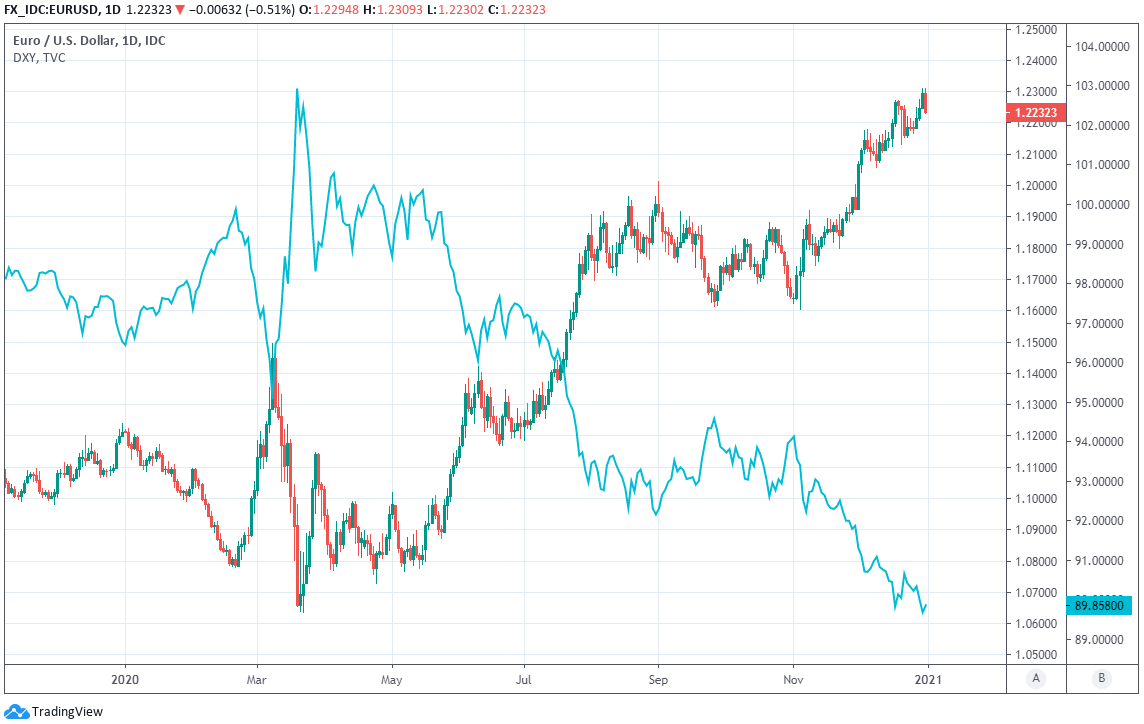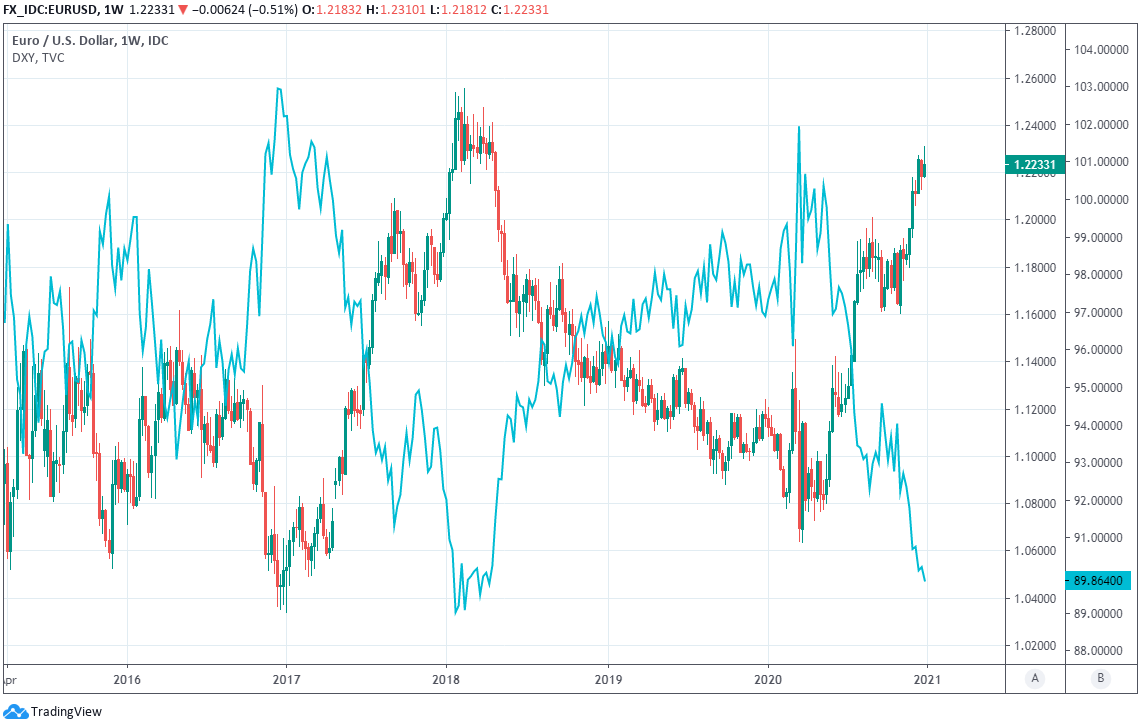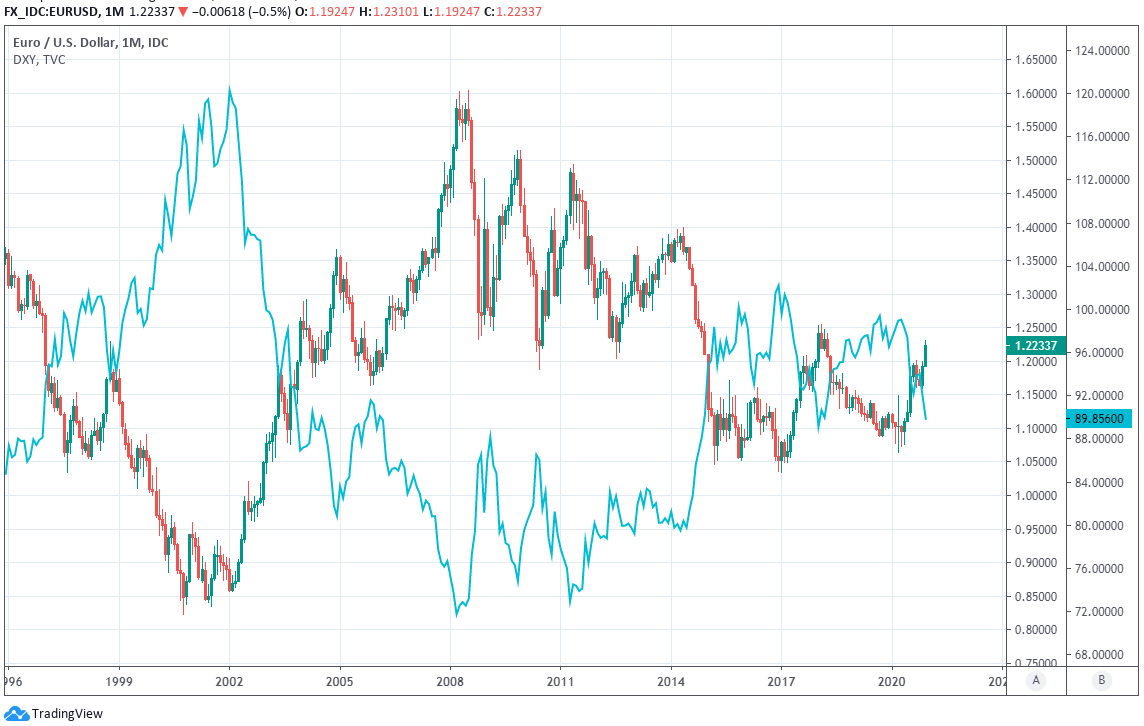Euro-Dollar Staggers and Stumbles into New Year but Green Grass Bedecks 2021's Pastures
- Written by: James Skinner
-
- EUR stumbles into New Year at bottom of barrel.
- But remains relative outperformer in FX for 2020.
- USD seen lifting EUR in 2021, to ECB's chagrin.
© Grecaud Paul, Adobe Stock
- EUR/USD spot rate at time of writing: 1.2261
- Bank transfer rate (indicative guide): 1.1832-1.1918
- FX specialist providers (indicative guide): 1.2077-1.2175
- More information on FX specialist rates here
The Euro staggered and stumbled to the bottom of the major currency barrel ahead of the New Year but remained one of the better performers for 2020 on Thursday, and was still widely viewed as a likely prominent beneficiary of a further anticipated decline of the U.S. Dollar in 2021.
Europe's single currency was lower against all major counterparts during the final hours of trading for 2020, although it retained annual gains over all but three of its nine largest rivals including the Swedish Krona, Australian Dollar and Swiss Franc while boasting a near-10% increase against the greenback.
The Euro-to-Dollar rate was 9.55% higher for 2020 and quoted at 1.2267, a level not previously seen since the early days of 2018, and after having entered the year mired in a struggle to keep its head above the 1.10 threshold.
While there's not much which hasn't changed for currency markets in the coronavirus-contaminated year of 2020, the single largest contribution to the Euro's change of fortune has been the undoing and subsequent unravelling of the U.S. Dollar at the hands of the Federal Reserve (Fed) and U.S. Treasury.
"In isolation, EUR does not offer an appealing story. The economy has been hit by the second wave of Covid-19 and related restrictive measures, the feeble growth prospects will last this quarter and next and the eurozone economy may again lag the US growth next year. The eurozone inflation outlook remains dismal," says Petr Krpata, chief EMEA strategist for currencies and interest rates at ING. "On the surface, this does not paint an appealing picture for the common currency. But this should not derail the positive EUR/USD outlook simply because the weak USD story is more dominant, in our view."
Above: Euro-to-Dollar rate shown at daily intervals alongside U.S. Dollar Index (blue).
Europe's economies, much like but more so than many others in the developed world, have long been unable to generate the inflation pressures that the European Central Bank (ECB) is charged with fostering through its monetary policies. But with Eurozone interest rates having reached new depths back in September 2019 only for those to be confirmed this year as the de facto floor for borrowing costs, Europe's single currency is now offering investors a steady inflation-adjusted return or 'real interest rate.'
'Real interest rates' are still negative in the Eurozone - much like elsewhere - but they aren't falling any longer like those in the U.S. and certainly not with the momentum of inflation-adjusted returns in America. This is a big part of why Krpata and the ING team see EUR/USD rising to 1.25 by the end of 2021.
{wbamp-hide start} {wbamp-hide end}{wbamp-show start}{wbamp-show end}
"The dollar is still nearly 10% rich (on a real trade-weighted basis) so has plenty of room to decline before it even erases the five recent years of overvaluation. Beyond that, the globalised nature of capital markets mean a weaker dollar makes US asset markets more attractive for global investment (and it means hedge ratios on overseas investors’ dollar exposure will fall). By the same token, thoughts of a currency war should only begin once the dollar is on the cheap side of its average," says Charles Dumas, chief economist at TS Lombard, an independent investment research provider into its 30th year. "Of course, in an ideal world the ECB would prefer a continuing decline."
This year's rally drew the ire of the ECB in September, when key members of the bank's governing council and eventually its chief economist, Philip Lane, began to warn of the impact that a stronger exchange rate could have on its elusive inflation target. Rising currencies make imported goods cheaper, creating scope for declines in consumer prices, while also disadvantaging exporters on which some of the bloc's manufacturing heavy economies rely.
Currency strength will remain a concern for the bank in 2021, which means the year is likely to be interspersed with occassional verbal complaints that could serve to generate periodic weakness and subsequent lacklustre price action.
Above: Euro-to-Dollar rate shown at weekly intervals alongside U.S. Dollar Index (blue).
Both ING and TS Lombard say there isn't a great deal the bank can do to disrupt the rally beyond those temporary impacts. TS Lombard's Dumas says the Eurozone will recover in 2021 "no matter if the currency is 5% higher or lower."
"With widescale USD weakness in place, it will be difficult for the ECB to tame the EUR/USD upside," Krpata says. "The pronounced bearish USD trend should be more than enough to offset the uninspiring euro story and lead to higher EUR/USD. But against the cyclical European currencies, be it Scandinavian or CEE FX, the euro should lag."
This year's landmark coronavirus recovery fund, which was agreed at EU level and is set to provide EU members with €750bn of grants and loans over the coming years, is cited by both firms as a likely offset to the macroeconomic headwind of a stronger exchange rate. It was approved after much negotiation at December's European Council summit, paving the way for funds to be released in the New Year - likely from June on.
But the greater stimulus for all economies will come from the growing list of coronavirus vaccines which are beginning to be rolled across Europe and North America, although in the short-term at least and certainly the early days of 2021, Europe and the wider world face the fallout connected with the ongoing second wave of coronavirus infections which has recently been buttressed by new and more infectious strains discovered. In addition, and next week, there's an important run-off election in the U.S.
"The US Senate race runoff in Georgia on 5 January is the next event risk to watch‑out for. A runoff race in the state of Georgia was triggered because no candidate received 50% of voter share in either race," says Elias Haddad, a London-based senior FX strategist at Commonwealth Bank of Australia. "If Democrats win both Georgia Senate races, Vice President‑elect Kamala Harris would be the tie breaking vote, giving the party unified control of the White House and Congress. This would raise the likelihood a material US infrastructure spending package gets fast tracked through Congress."
Above: Euro-to-Dollar rate shown at monthly intervals alongside U.S. Dollar Index (blue).







